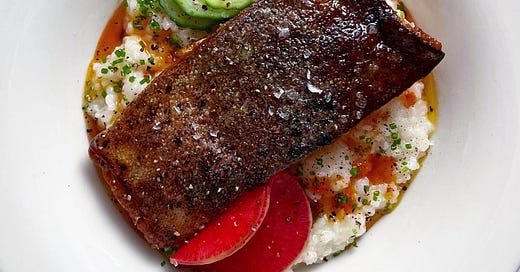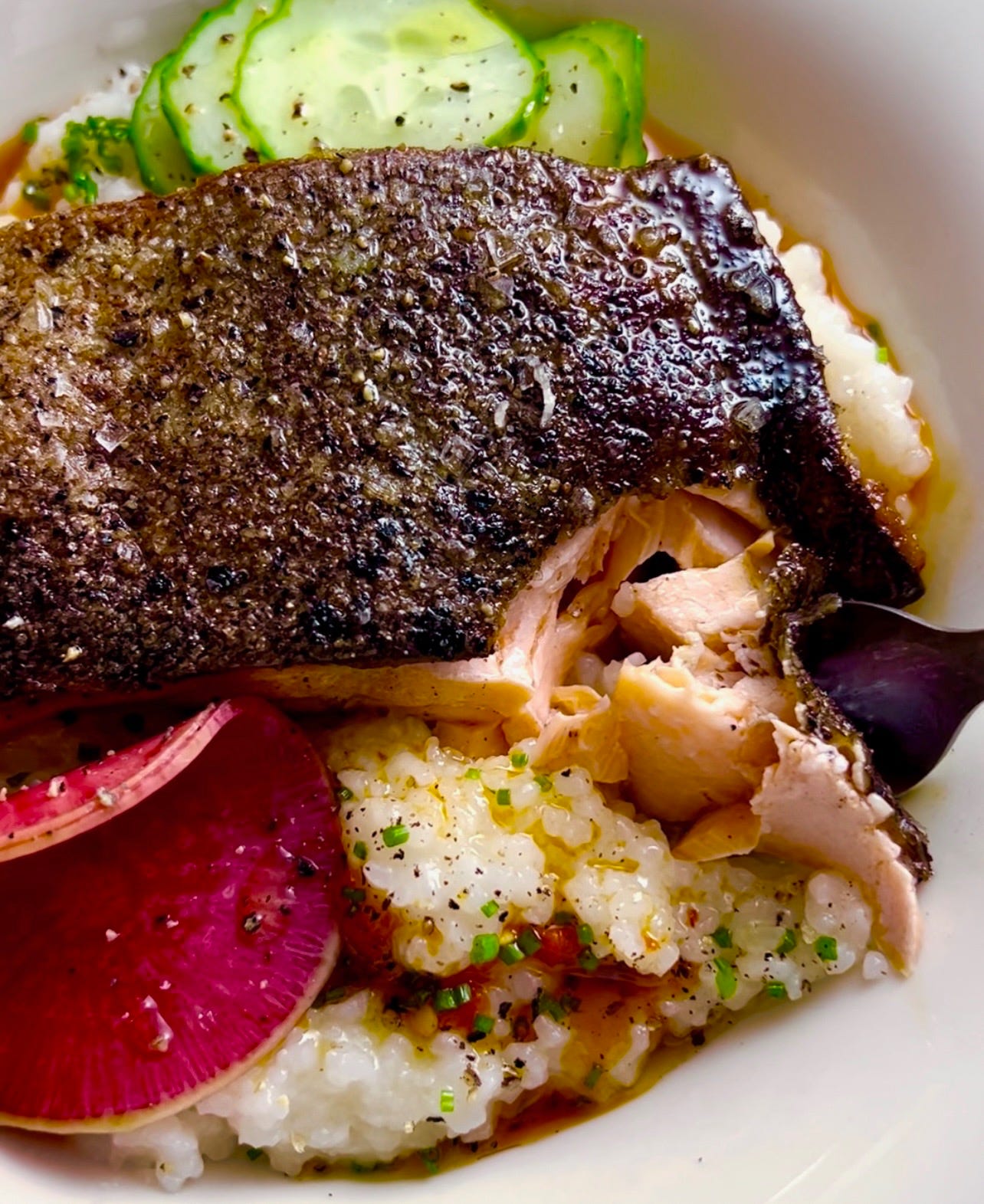I’ve been missing Charleston lately, which I visited for the first time last August. It may just be the slog of a New York winter and the dizzying process of snagging a coveted, Resy-alerted table in this city, but Charleston’s balmy weather and casually fantastic restaurants sound nice right now. My nostalgia has also been piqued by an excellent bag of Delta Blues rice grits, otherwise known in the South as rice middlins, that I included in a recent Farm to People order. Rice middlins are essentially broken rice — the imperfect, discarded byproducts of rice production that become, almost alchemically, a rich and comforting porridge somewhere between traditional corn grits and risotto. (In fact, they remind me mostly of pastina, though I think — perhaps controversially — that middlins are better than all three.)
A homey Southern dish like this calls for some proper seafood as per Lowcountry tradition, and while grilled Gulf shrimp would work perfectly, I’ve been enjoying them with a supremely crisped and buttered piece of fish on top. The crunchy, caramelized skin of a filet — be it salmon, Arctic char, rainbow trout, striped bass, or any number of fish — pairs well with the smooth consistency of middlins.
However, crispy fish skin is a difficult skill to master, and one that I’ve struggled with for a while. Getting it right is one of the most satisfying accomplishments in home cooking. The secret is constantly basting the fish with butter, as you would a steak. Below is my personal technique, adapted from a Danny Bowien recipe (required viewing!) and tweaked through trial and error. Two things to note at the outset:
The type of pan you use is critical. In my experience, non-stick pans stymie the level of caramelization you want for the skin, so I would avoid those. The best pan I’ve found is a pre-seasoned BK carbon steel, which would work best for this after a few months of use. It’s lightweight and develops a naturally non-stick surface over time that still gives you great surface contact and browning. You can use a stainless steel pan, but to avoid the skin sticking, you will want to add a small amount of oil to the pan before dropping the fish (as opposed to after, which works well with my BK carbon steel pan).
You can dust the skin with Wondra or semolina flour, which I do occasionally and can help crisp things up. However, I find this to be optional and not nearly as important as basting.
Crispy Arctic Char with Rice Middlins
Ingredients
1 pound of Arctic char (or salmon, steelhead trout, etc.), cut into ~2.5 inch wide filets (this will yield approximately 3 servings)
1 cup of Delta Blues white rice grits
2 cups of chicken stock
1 stick of unsalted butter
Approx. 10-15 round slices of medium-sized Japanese cucumber
Approx. 5-6 round slices of watermelon radish (or any radish)
1 tablespoon of chopped Calabrian chili in oil
1 lemon wedge and zest of a lemon
Red wine vinegar or rice vinegar
Handful of chives, chopped very fine
Extra virgin olive oil
Kosher salt
White sugar
Cracked black peppercorns
Instructions
Prepare the pickled cucumbers and radishes: add the cucumber and radish slices in separate small bowls. Add 2 tablespoons of vinegar, a few generous pinches of salt and sugar, and just enough water to submerge the vegetables in each bowl. Cover with plastic wrap and set aside in the fridge.
Prepare the rice grits: measure 1 cup of rice grits and wash them thoroughly in a strainer. Add to a small saucepan and add 2 cups of stock, a pat of butter, and 2-3 pinches of salt. Bring to a boil, stir vigorously, then turn the heat down to the lowest setting and cover the pot with just a small opening (watch out for it boiling over). Let this simmer for approximately 20 minutes, or until the liquid is fully absorbed and the rice grits are soft. If at any point the bottom starts to burn, stir gently and briefly remove the pot from the heat. Once done, add another tablespoon of butter, salt, and black pepper, and stir. Cover and set aside from the heat.
Remove the pickles from the fridge. In a small bowl, combine the Calabrian chili with olive oil, lemon zest and the juice of a small lemon wedge. Stir to incorporate.
Pat your fish filets dry — the skin should be as dry as possible. Set a pan over high heat. Once the pan is vigorously smoking, add a generous amount of salt and pepper to every spot on the fish. (If you are making all 3 filets, you may need to cook them in stages to prevent overcrowding.)
Place the filets in the pan skin-side down, directing them away from you. As soon as they’re in the pan, gently but firmly press down on them with a fish spatula. This will make even contact for uniform browning and prevent the filet from seizing up.
Add roughly 2 tablespoons of oil to the pan, and place a large chunk of butter on top of each filet.
Throughout cooking, you should occasionally and gingerly lift the edges of the fish to make sure the skin isn’t burning or sticking; you may need to adjust the heat down if you see signs of burning. The skin should be gradually browning, but not too brown or black. If the fish is sticking, it likely needs more time to cook; a squeeze of lemon or even a small splash of water can help it dislodge.
After about 5 minutes of cooking, the edges should be cooked and browning. Check the skin and if it looks sufficiently golden brown, turn down the heat to low, knock any remaining butter off the filet and onto the pan surface, and flip the fish.
Once the fish is flipped skin-side up, grab a spoon and immediately start basting the fish in the oil and butter. Angle the pan slightly towards you in order to scoop up the liquid, and then deposit it over the skin. You should do this constantly and take care to cover all of the skin. It will take approximately 3-4 minutes of basting to get the skin really crispy and for the underside to be fully cooked.
If you’re cooking Arctic char or salmon, you should remove the fish from the pan at the very first sign of white fat seeping from the filet. You don’t want to cook past this point as it will likely be overcooked. Place the fish on a plate, skin-side up, and sprinkle some flaky salt on the skin.
Plate the warm grits and spoon some of the Calabrian chili over them. Sprinkle the chives over the grits. Place a single fish filet in the center, and garnish with the cucumbers and radishes. Drizzle a bit of olive oil over the plate.



